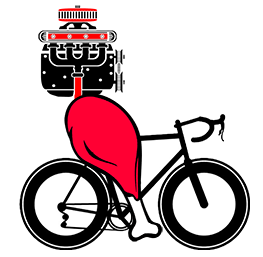We live and ride bikes in Texas. Yes, that Texas. The one that is a summer suburb of hell, where the heat index is often 104ºF + (40ºC) and real temperatures of 100ºF (37ºC) are common. Cycling in the heat is tough. Water or hydration mixes go down better cold than hot and also play a role in lowering your core temperature.
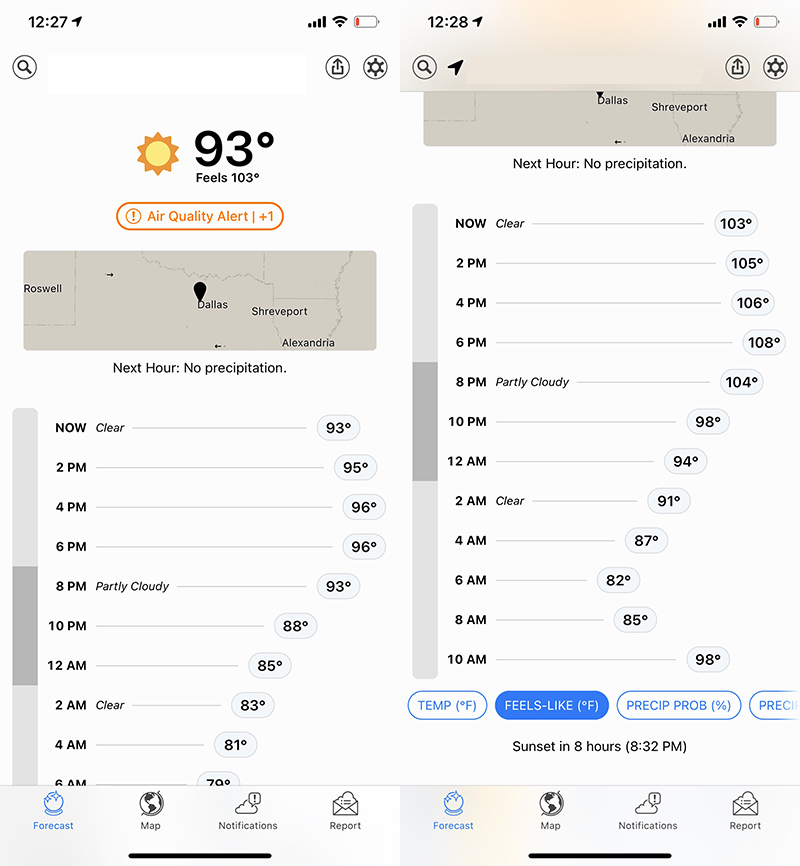
We wanted to do a comparison to find the coldest water bottle to survive cycling in extremely hot weather. No one wants to be sipping on warm hydration mixes or hot water in these high temperatures.
The Test Protocols
In our attempt to find the best cycling water bottle, here is the test we performed.
- We filled each bottle with 16oz of water and froze the bottles in a deep freeze for 48 hours.
- We then lined up each bottle in direct sunlight on a day in Texas where the heat index was 104-105º.
- We took the internal water temperature at 1.5 hour using two digital thermometers. Colder is better.
- We measured the external water bottle temperature using a scan thermometer. (Note: This didn’t directly correlate to internal temperatures).
- At two hours, we poured out and weight the melted water while leaving the unmelted ice block in the bottle. Less water melted is better.
- We repeated this pour and weigh at three hours. Less total water melted is better.

The Contendors: Water Bottles We Tested
We tested what we had in the cabinet and a few we ordered. As this wasn’t a funded-approved exercise by the Mrs., we kept it real. Still, we have a broad sampling.
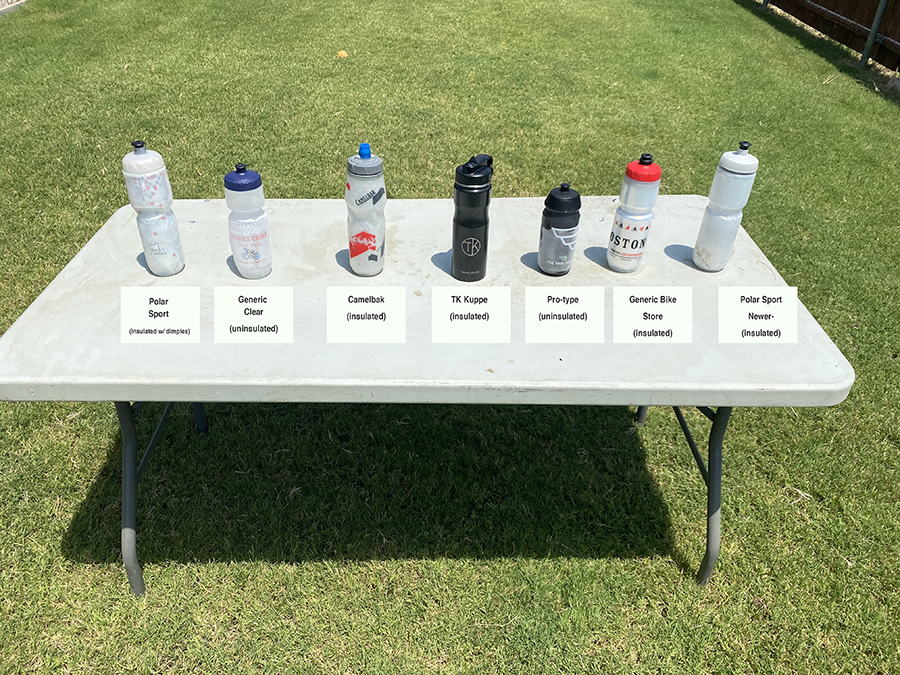
- A typical pro-uninsulated bottle in the color black. (Baseline bottle)
- A typical clear uninsulated bottle.
- A generic insulated bottle (bike store branded).
- A Polar insulated bottle with interior indentions (aka several dimples).
- A Polar bottle without interior indentions, slightly different lid.
- A Camelbak insulated water bottle.
- A TP Kuppe aluminum insulated water bottle.
- Unfortunately, our Camelbak Podium Ice and Podium Chill bottles seemed too have disappeared. One of the collegiates at our home may have “borrowed” it. (Here is a separate test on those two by a guy on Reddit. Both would still lose to our winner by a large margin. A BIVO water bottle also arrived too late to test. However, even eyeballing the degree of insulation shows it will lose to the ultimate winner. We will repeat this test most likely. Give us your recommendations of bike water bottles to include as a comment.
The Results
| Bottle | 1.5 Hr Internal Water Temp (F) | 1.5 Hour External Surface Temp | 2 Hr Amount of Melted Water (Less is Better) | 3 Hr Amount of Total Melted Water (Less is Better) | Bottle Weight Empty (for Weight Weenies) |
| Pro’s Closet Uninsulated Black | 69ºF | 78ºF | 453g / 16 oz (all) | All melted at 2hrs. | 80g |
| Standard Clear Uninsulated | 52ºF | 62ºF | 421g / 14.8oz | 453g / 16oz (all) | 86g |
| Camelbak Insulated | 43ºF | 80ºF | 222g / 7.8oz | 353g / 12.5oz | 114g |
| Polar with Dimples | 46ºF | 83ºF | 217g / 7.7oz | 333 / 12.5oz | 153g |
| Polar without Dimples (newer model) | 41ºF | 79ºF | 191g / 6.7oz | 309g / 10.9oz | 141g |
| Generic Bike Store Insulated | 45ºF | 82ºF | 223g / 7.9oz | 360g / 12.7oz | 158g |
| TK Kuppe Steel Insulated | 35ºF | 120ºF | 21g / 0.7oz | 41g / 1.4 | 362g |
A Clear Coldest Water Bottle Winner with A Caveat
As far as keeping water cold, the Travel Kuppe Vacuum Insulated Stainless Steel Cycling Sports Water Bottle destroyed the competition (that’s not an affiliate link, btw). It kept the water much colder than any competitor and the melt rate was insanely lower. It wins the best-insulated cycling water bottle award for keeping things cold.
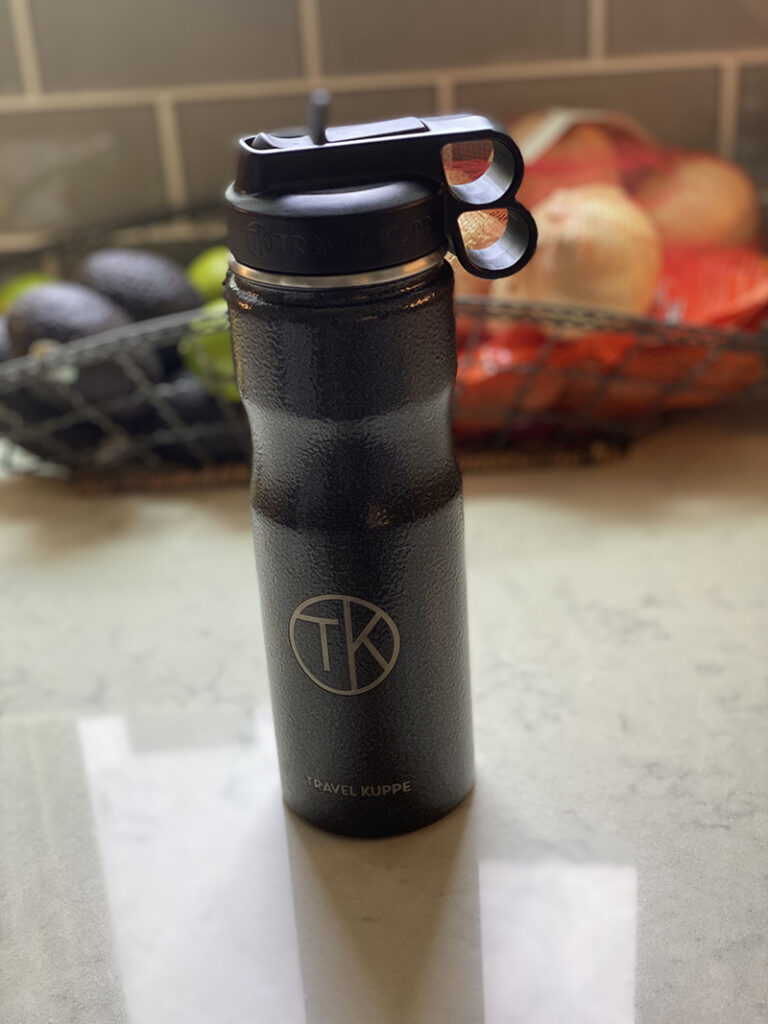
But some points to note before you rush off and buy it:
- It is by far the heaviest bottle here. If you are a weight weenie, note that it’s ~ 221g heavier than a traditional, plastic insulated bottle. Of course, weigh that against a heat-infused rider melt down on course. Some days the weight might be worth it.
- It got quite hot to the touch surface-wise. Not like third-degree burns but definitely hot. Notice this did NOT affect internal temperature.
- It isn’t squeezable, meaning you have to tip it to drink. The flow rate is okay but not in the realm of the Bivo (which made it too late for our test this round.) If they could emulate the Bivo’s high flow rate, it would be a fantastic improvement.
- It has a flip cap, not a traditional water bottle cap. But the cap is easy to grab with a finger ring and openable via one hand. Still, we would like to see a more traditional bike bottle lid.
- We haven’t done any testing to see how well the stainless steel bottle stays in the bike bottle cage on particularly rougher rides. We want to test this with gravel for sure.
- If it drops on concrete or rocks, not sure how it will fair dent-wise, but it seems pretty solid. We won’t be testing that on our $35 bottle. You can, let us know. They do offer a lifetime warranty. That’s nice.
- You will want to make sure you grip the bottle carefully as you remove it from the rack, as it might slip from your fingers more easily than a plastic bottle. Granted, if you grab it by the finger ring, this is less of an issue. There was, however, zero sweat on the bottle surface unlike all the other bottles.
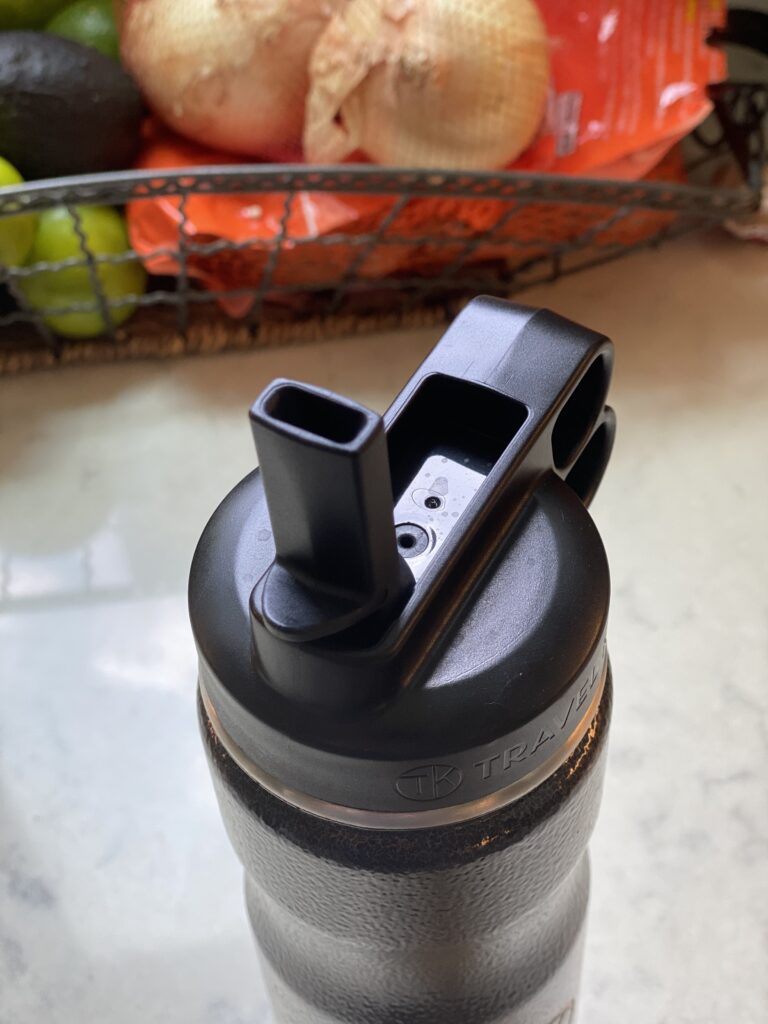
General Things to Note
- The winner has no BPA, though many bottles are bpa free plastic.
- No plastic eco concerns with the stainless steel bottle.
- Plastic bottles wear out and water does sometimes taste funny in them.
- Keeping a drink colder means a more likely rate of proper hydration. Especially after a few hours.
- If you aren’t elite, cycling bottles probably aren’t the podium difference-maker for you. Training more effectively can definitely overcome the loss due to weight or aero-effect unless you are at the razor’s edge, already.
- Insulated water bottles ruled the test. Don’t even mess with an uninsulated bottle in extreme heat unless you have a team car and/or domestique at your service.
Our Final Consensus
We will probably take out the Travel Kuppe as bottle #2 on long training rides where we aren’t as weight conscious and are willing to even pull over for a bit to sip it. We may even use it in a few insanely long, hot unsupported races as long as the vertical ascent of the course isn’t crazy. For any sane race or t-shirt ride with stops, we’ll skip it. The cold water payoff is nice.
Stay safe. Drink water. Take electrolytes. Use lots of ice cubes. Don’t think using a larger bottle is uncool. And remember, cycling is supposed to be fun.
Legal disclaimer for goofballs: No, we aren’t telling you to go out and ride in 100ºF degree weather. That’s between you and your doctor.

Jordan Fowler has experience as a head swimming coach of the Frisco Swim Team, a TAAF-awarded coach, a track and field distance running consultant for select Texas High School runners, and has competed as a triathlete, road runner, and cyclist. Though he is remarkably slower than he was in his 20s and 30s, he still enjoys endurance sports and sports science studies.
